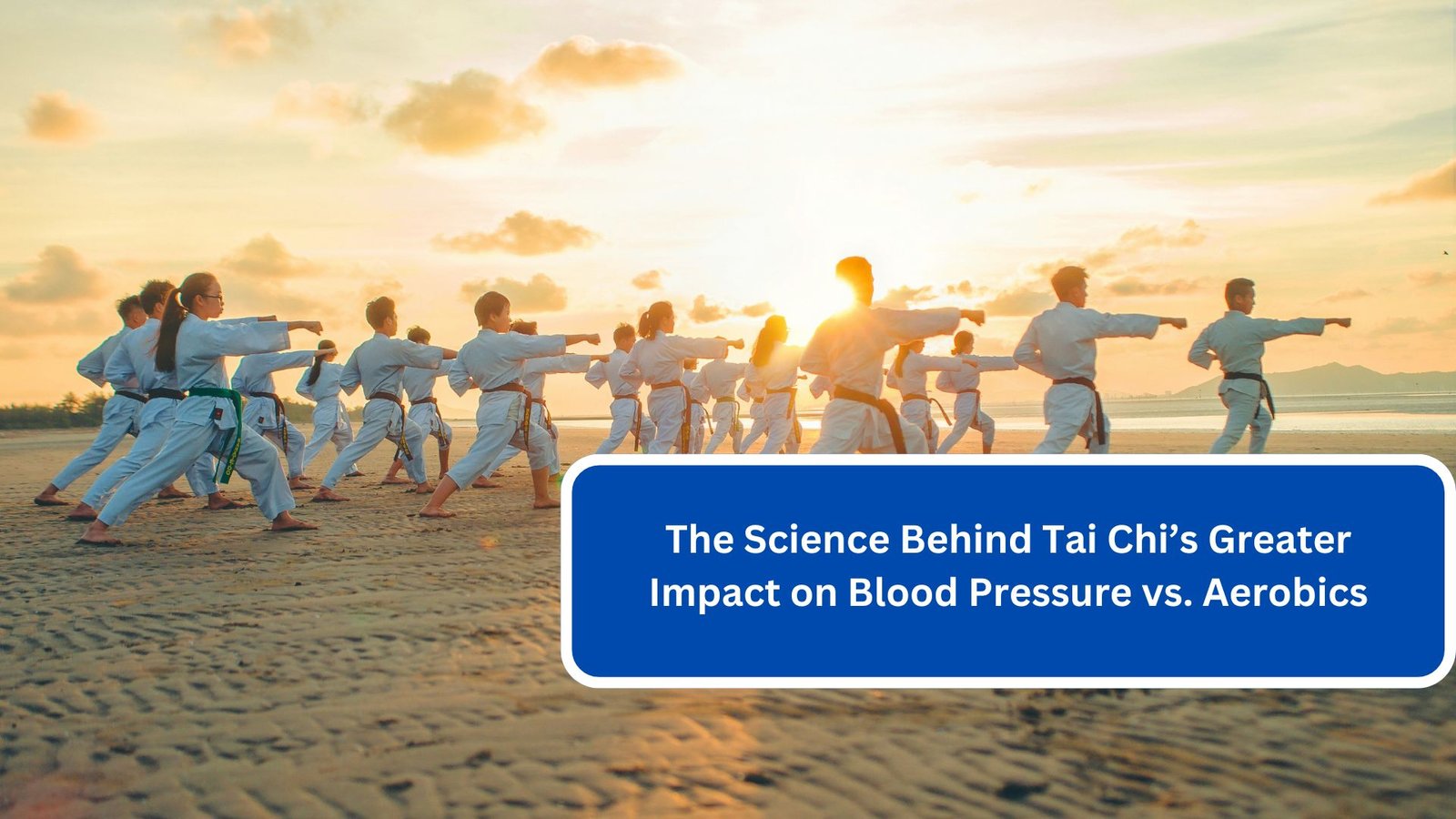Hypertension, or high blood pressure, is a widespread health issue affecting millions of individuals worldwide. Managing blood pressure is crucial for preventing serious health complications, including heart disease and stroke. Among various lifestyle interventions, exercise plays a significant role in controlling blood pressure. While aerobic exercise has long been endorsed for its cardiovascular benefits, recent studies highlight the unique advantages of Tai Chi, a traditional Chinese martial art characterized by slow, flowing movements and mindfulness. This article delves into the science behind why Tai Chi may have a greater impact on blood pressure compared to traditional aerobic exercises.
Understanding Hypertension
Hypertension is characterized by elevated blood pressure levels, typically defined as readings of 130/80 mmHg or higher. The condition can be caused by various factors, including genetics, poor diet, obesity, stress, and lack of physical activity. Unmanaged hypertension can lead to serious complications, including:
- Heart Disease: Increased workload on the heart can lead to heart failure or other cardiovascular diseases.
- Stroke: High blood pressure can damage blood vessels in the brain, increasing the risk of stroke.
- Kidney Damage: Hypertension can impair kidney function, leading to chronic kidney disease.
The Role of Exercise in Blood Pressure Management
Regular physical activity is a cornerstone of hypertension management. Exercise has been shown to help reduce blood pressure by:
- Strengthening the Heart: Regular activity improves cardiovascular health by strengthening the heart muscle and enhancing its efficiency in pumping blood.
- Promoting Weight Loss: Exercise helps maintain a healthy weight, reducing the burden on the cardiovascular system.
- Reducing Stress: Physical activity can alleviate stress, which is a known contributor to high blood pressure.
Aerobic Exercise: Traditional Approaches
Aerobic exercises include activities that elevate heart rate and improve cardiovascular endurance, such as running, cycling, and swimming. These exercises have been extensively researched for their impact on blood pressure. Key benefits of aerobic exercise include:
1. Blood Pressure Reduction
Research consistently indicates that moderate-intensity aerobic exercise can lead to significant reductions in both systolic and diastolic blood pressure. Studies have shown that regular aerobic activity can lower systolic blood pressure by 5 to 10 mmHg and diastolic blood pressure by 3 to 7 mmHg in individuals with hypertension. The effectiveness of aerobic exercise in reducing blood pressure is largely attributed to:
- Increased Cardiac Output: Aerobic activities enhance the heart’s pumping capacity, improving blood circulation.
- Improved Endothelial Function: Regular aerobic exercise promotes the health of the endothelium (the inner lining of blood vessels), helping them to relax and reduce vascular resistance.
2. Stress Relief
Aerobic exercise triggers the release of endorphins, which are chemicals in the brain that act as natural painkillers and mood elevators. This effect can help reduce stress and anxiety, contributing to lower blood pressure. However, high-intensity aerobic exercise may sometimes lead to increased cortisol levels, particularly if the individual is not accustomed to the exertion, which could counteract the benefits.
Tai Chi: A Mind-Body Approach
Tai Chi is a low-impact exercise characterized by slow, controlled movements and a focus on breathing and mindfulness. It has gained recognition for its potential health benefits, particularly in managing blood pressure. The unique characteristics of Tai Chi contribute to its effectiveness:
1. Mindfulness and Relaxation
The meditative aspects of Tai Chi emphasize relaxation and mental focus. This mindfulness practice can significantly reduce stress levels, which is crucial for blood pressure management. Research shows that individuals who practice Tai Chi experience lower levels of the stress hormone cortisol, leading to enhanced relaxation and lower blood pressure.
2. Enhanced Autonomic Nervous System Regulation
Tai Chi promotes a balanced autonomic nervous system, which plays a vital role in regulating blood pressure. The gentle movements and controlled breathing associated with Tai Chi activate the parasympathetic nervous system, which helps lower heart rate and blood pressure. In contrast, aerobic exercises often stimulate the sympathetic nervous system, which can raise heart rate and blood pressure during high-intensity activity.
3. Improved Balance and Flexibility
Tai Chi enhances physical balance and flexibility, reducing the risk of falls and injuries, particularly among older adults. Improved physical stability contributes to overall well-being, allowing individuals to engage in more physical activity without fear of injury, which can lead to better long-term health outcomes.
4. Evidence Supporting Blood Pressure Reduction
Several studies have demonstrated the efficacy of Tai Chi in lowering blood pressure. For instance:
- A meta-analysis found that Tai Chi practitioners experienced reductions in both systolic and diastolic blood pressure comparable to those achieved through aerobic exercise. Some studies reported an average decrease of 5 to 8 mmHg in systolic blood pressure among regular Tai Chi practitioners.
- Research indicates that Tai Chi is particularly beneficial for older adults, who are often more susceptible to hypertension and may face challenges in engaging in high-intensity aerobic exercises.
Comparing Tai Chi and Aerobics: The Science
1. Mechanisms of Action
- Aerobics primarily lowers blood pressure through enhanced cardiac output and improved vascular function. The immediate effects of aerobic exercise can lead to acute drops in blood pressure; however, the long-term benefits depend on consistent, moderate to high-intensity exercise.
- Tai Chi, on the other hand, utilizes mindfulness, relaxation, and gentle movements to achieve a more profound long-term effect on blood pressure regulation. Its influence on the autonomic nervous system and stress reduction contributes to a sustained decrease in blood pressure levels.
2. Accessibility and Adherence
Aerobic exercises can be challenging for certain populations, including older adults or those with physical limitations. Tai Chi is generally more accessible and may promote higher adherence rates due to its gentle nature and emphasis on relaxation. This adherence is crucial for achieving long-term benefits in blood pressure management.
3. Psychological Impact
The psychological benefits of Tai Chi, including improved mental well-being and stress reduction, contribute significantly to its efficacy in lowering blood pressure. While aerobic exercise can also enhance mood, the heightened mindfulness aspect of Tai Chi may provide a deeper, more sustained psychological benefit, fostering a holistic approach to health.
Conclusion
Both Tai Chi and aerobic exercise offer valuable benefits for managing blood pressure, yet they do so through different mechanisms and approaches. While traditional aerobic exercise remains a highly effective method for reducing blood pressure, Tai Chi presents a compelling alternative that emphasizes relaxation, mindfulness, and balance.
For individuals struggling with hypertension or those seeking a more holistic approach to health, integrating Tai Chi into their exercise routine may yield significant benefits. Ultimately, the best choice depends on individual preferences, health status, and lifestyle factors, but both forms of exercise can play a critical role in managing blood pressure and enhancing overall well-being.

